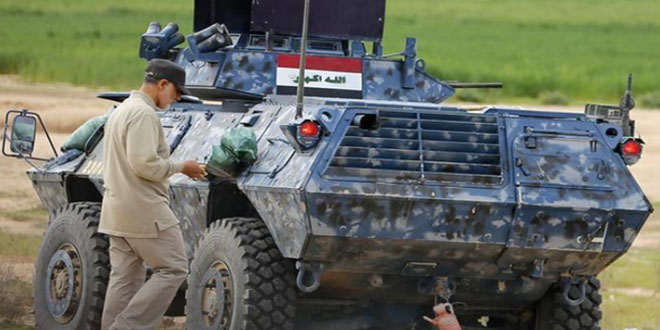
By Dina Esfandiary and Ariane M. Tabatabai 7
Inline image 1Iranian Revolutionary Guard Commander Qassem Soleimani visits the frontline during an offensive against Islamic State militants in the town of Tal Ksaiba in Salahuddin province March 8, 2015
Islamic State remains strong. It may have lost ground in the Middle East this year, but it has upped its game beyond the territories it controls in Iraq and Syria, inspiring or conducting a terrorist attack every 84 hours since June.
It successfully hit two of the three top targets on its list: France and the United States. To date, however, it failed to perpetrate a successful attack on its third target: Iran.
It’s not for lack of trying. Iran actively fights Islamic State — and Tehran’s counterterrorism efforts have succeeded where others have not.
Iran’s goal is twofold: Undermine Islamic State’s spread, ideology and vision, which promotes a sectarian agenda, while working to prevent attacks on Iranian soil. Iran’s efforts in neighboring Iraq and Syria are slowly paying off, as the territory held by the group continues to shrink.
Iran itself, however, remains a more vulnerable target than the European Union and the United States, not least because it shares a 900-mile border with Iraq. Islamic State’s attempts to target Iran should have been more successful, but Iran’s security apparatus has so far mitigated the threat.
Iran developed its counterterrorism policy over the course of several decades. Part of it was developed with the help of the U.S. intelligence community and the Israeli Mossad, when the three countries worked together on security issues until the 1979 Islamic Revolution that toppled the shah. Tehran put other strategies and institutions in place after the revolution.
Counterterrorism is now divided between several key organizations, including the police force under the Interior Ministry, the military, numerous intelligence organizations and the Revolutionary Guards. Their effectiveness is a testament to the government’s ability to coordinate them successfully in a volatile political climate. Iran is in the throes of tense political infighting as it prepares for next year’s presidential elections against the backdrop of heated debates over the benefits of opening up economically and politically to the rest of the world following 2015’s landmark nuclear deal.
Iran’s counterterrorism tactics remain opaque and misunderstood in the West. Tehran has been active in Iraq and Syria militarily because it believes that by taking the battle onto Islamic State turf it can stop the group from advancing into Iran. While the extent of Iran’s presence in Iraq and Syria was unclear at first, it now increasingly publicizes its involvement there. This sends a message to Islamic State: Iranians are on the ground, connected to local populations and various political groups, and won’t allow Islamic State to get close to Iran.
Tehran wants to show that when Iranians fight and die to protect Shiite Muslims and their religious shrines abroad, it isn’t just because of ideology, but to keep the militants away from Iran’s borders. Supreme Leader Ayatollah Khamenei said recently that the “martyrs” were in Syria and Iraq to protect their homeland.
Iran began its messaging campaign in 2014, when Islamic State declared the creation of a “caliphate.” Revolutionary Guard commander Qassem Soleimani’s social media presence was the first step: He was frequently photographed in Iraq, and more recently in Syria, engaging with various political groups. In addition to sending a signal to Islamic State, it sought to reassure the Iranian public of Tehran’s commitment to the fight against Islamic State. Today, every fallen Iranian soldier is used to underscore this message.
Iran has also successfully foiled several planned terror attacks within its borders. In June, Iranian Intelligence Minister Mahmoud Alavi announced that 20 terrorist cells had been dismantled the previous month. He added that Tehran this summer had prevented the biggest Islamic State attack on Iranian soil, involving 50 different targets throughout the capital, 100 kg (220 lbs) of explosives, about 10 operatives and hundreds of thousands of dollars.
This month, Iranian security forces said they discovered an Islamic State base, killed an operative and dismantled a cell in the Western city of Kermanshah, close to the border with Iraq. Last week, Alavi claimed that Iran had prevented 1,500 Iranians youth from joining Islamic State.
Abroad, Iran tries to change its image as a sectarian player and works with Shias and Sunnis alike, including in encouraging recruitment for the Iraqi army. Iran’s government has also reached out to its own Sunni minority — part of its bid to be viewed as the leader of all Muslims, rather than just the Shias who make up some 90 percent of its population.
These efforts have met with mixed success. Few non-Iranian Sunnis want to work with Tehran. But inside the country, Sunni leaders have worked closely with the government on preventive measures, such as community programs aimed at preventing local Sunnis from joining the Sunni-dominated Islamic State.
Despite its success to date, many in the Iranian leadership are aware of Iran’s shortcomings in counterterrorism efforts. Iran is still a victim of its political system. The constant infighting between different factions results in a sort of one-step forward, two-steps back policy implementation. Despite the government’s domestic efforts to work with Sunnis, for example, themass execution of 20 Sunni militants in August is likely to upset some of the political progress.
Iran is in the game, whether the West likes it or not. It shares similar challenges in the fight against Islamic State — including a need to deal with its porous border with Iraq.
But for now, at least, Tehran’s complex counterterrorism policy is keeping Islamic State at bay.
Dina Esfandiary is a MacArthur Fellow at the Centre for Science and Security Studies, Department of War Studies, King’s College London. Ariane M. Tabatabai is a visiting assistant professor in the Security Studies Program at the Edmund A. Walsh School of Foreign Service, Georgetown University.
 khalijefars News, Blogs, Art and Community
khalijefars News, Blogs, Art and Community








